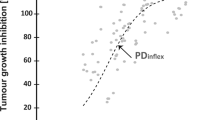Abstract
Purpose. To predict the response of cells to chemotherapeutic agents based on gene expression profiles, we performed a chemoinformatic study of a set of standard anticancer agents assayed for activity against a panel of 60 human tumor-derived cell lines from the Developmental Therapeutics Program (DTP) at the National Cancer Institute (NCI).
Methods. Mechanistically-relevant gene:drug activity associations were identified in the scientific literature. The correlations between expression levels of drug target genes and the activity of the drugs against the NCI's 60 cell line panel were calculated across and within each tumor tissue type, using published drug activity and gene expression data.
Results. Compared to other mechanistically-relevant gene-drug associations, that of triciribine phosphate (TCN-P) and adenosine kinase (ADK) was exceptionally strong—overall and within tumor tissue types—across the 60 cell lines profiled for chemosensitivity (1) and gene expression (2).
Conclusion. The results suggest ADK expression may be useful for stratifying TCN-P-responsive vs. non-responsive tumors. Based on TCN-P's mechanism of action and the observed TCN-P:ADK association, we contend that catalytic drug activation provides a rational, mechanistic basis for personalizing cancer treatment based on tumor-specific differences in the expression of drug-activating enzymes.
Similar content being viewed by others
References
M. R. Boyd. The NCI In Vitro Anticancer Drug Discovery Screen. In B. Teicher (ed), Anticancer Drug Development Guide: Preclinical Screening, Clinical Trials and Approval, Humana Press, Totowa, New Jersey, 1995, pp. 23–41.
J. E. Staunton, D. K. Slonim, H. A. Coller, P. Tamayo, M. J. Angelo, J. Park, U. Scherf, J. K. Lee, W. O. Reinhold, J. N. Weinstein, J. P. Mesirov, E. S. Lander, and T. R. Golub. Chemosensitivity prediction by transcriptional profiling. Proc. Natl. Acad. Sci. USA 98:10787–10792 (2001).
R. H. Shoemaker, D. A. Scudiero, G. Melillo, M. J. Currens, A. P. Monks, A. A. Rabow, D. G. Covell, and E. A. Sausville. Application of high-throughput, molecular-targeted screening to anticancer drug discovery. Curr. Top. Med. Chem. 2:229–246 (2002).
A. A. Rabow, R. H. Shoemaker, E. A. Sausville, and D. G. Covell. Mining the National Cancer Institute's tumor-screening database: identification of compounds with similar cellular activities. J. Med. Chem. 45:818–840 (2002).
O. Keskin, I. Bahar, R. L. Jernigan, J. A. Beutler, R. H. Shoemaker, E. A. Sausville, and D. G. Covell. Characterization of anticancer agents by their growth inhibitory activity and relationships to mechanism of action and structure. Anticancer Drug Des. 15:79–98 (2000).
J. N. Weinstein, T. G. Myers, P. M. O'Connor, S. H. Friend, A. J. Fornace Jr., K. W. Kohn, T. Fojo, S. E. Bates, L. V. Rubinstein, N. L. Anderson, J. K. Buolamwini, W. W. van Osdol, A. P. Monks, D. A. Scudiero, E. A. Sausville, D. W. Zaharevitz, B. Bunow, V. N. Viswanadhan, G. S. Johnson, R. E. Wittes, and K. D. Paull. An information-intensive approach to the molecular pharmacology of cancer. Science 275:343–349 (1997).
U. Scherf, D. T. Ross, M. Waltham, L. H. Smith, J. K. Lee, L. Tanabe, K. W. Kohn, W. C. Reinhold, T. G. Myers, D. T. Andrews, D. A. Scudiero, M. B. Eisen, E. A. Sausville, Y. Pommier, D. Botstein, P. O. Brown, and J. N. Weinstein. A gene expression database for the molecular pharmacology of cancer. Nat. Genet. 24:236–244 (2000).
D. T. Ross, U. Scherf, M. B. Eisen, C. M. Perou, C. Rees, P. Spellman, V. Iyer, S. S. Jeffrey, M. Van de Rijn, M. Waltham, A. Pergamenschikov, J. C. Lee, D. Lashkari, D. Shalon, T. G. Myers, J. N. Weinstein, D. Botstein, and P. O. Brown. Systematic variation in gene expression patterns in human cancer cell lines. Nat. Genet. 24:227–235 (2000).
L. L. Wotring, G. W. Crabtree, N. L. Edwards, R. E. Parks Jr., and L. B. Townsend. Mechanism of activation of triciribine phosphate (TCN-P) as a prodrug form of TCN. Cancer Treat. Rep. 70:491–497 (1986).
R. B. Schilcher, J. D. Young, and L. H. Baker. Reversed-phase high-performance liquid chromatographic determination of tricyclic nucleoside and tricyclic nucleoside 5′-phosphate in biological specimens. J. Chromatogr. 337:55–62 (1985).
L. L. Wotring, J. E. Passiatore, J. L. Roti Roti, J. L. Hudson, and L. B. Townsend. Effects of the tricyclic nucleoside 6-amino-4-methyl-8-(beta-D-ribofuranosyl)-pyrrolo[4,3,2-de]pyrimido[4,5-c]pyridazine on the viability and cell cycle distribution of L1210 cells in vitro. Cancer Res. 45:6355–6361 (1985).
R. G. Ptak, K. Z. Borysko, A. R. Porcari, J. L. Buthod, L. E. Holland, C. Shipman Jr., L. B. Townsend, and J. C. Drach. Phosphorylation of triciribine is necessary for activity against HIV type 1. AIDS Res. Hum. Retroviruses 14:1315–1322 (1998).
A. R. Porcari, R. G. Ptak, K. Z. Borysko, J. M. Breitenbach, S. Vittori, L. L. Wotring, J. C. Drach, and L. B. Townsend. Deoxy sugar analogues of triciribine: correlation of antiviral and antiproliferative activity with intracellular phosphorylation. J. Med. Chem. 43:2438–2448 (2000).
L. G. Feun, N. Savaraj, G. P. Bodey, K. Lu, B. S. Yap, J. A. Ajani, M. A. Burgess, R. S. Benjamin, E. McKelvey, and I. Krakoff. Phase I study of tricyclic nucleoside phosphate using a five-day continuous infusion schedule. Cancer Res. 44:3608–3612 (1984).
K. Hoffman, F. A. Holmes, G. Fraschini, L. Esparza, D. Frye, M. N. Raber, R. A. Newman, and G. N. Hortobagyi. Phase I-II study: triciribine (tricyclic nucleoside phosphate) for metastatic breast cancer. Cancer Chemother. Pharmacol. 37:254–258 (1996).
Author information
Authors and Affiliations
Corresponding author
Rights and permissions
About this article
Cite this article
Shedden, K., Townsend, L.B., Drach, J.C. et al. A Rational Approach to Personalized Anticancer Therapy: Chemoinformatic Analysis Reveals Mechanistic Gene-Drug Associations. Pharm Res 20, 843–847 (2003). https://doi.org/10.1023/A:1023893700386
Issue Date:
DOI: https://doi.org/10.1023/A:1023893700386




